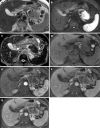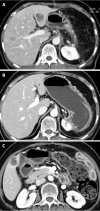Sarcomatoid carcinoma of the pancreas - multimodality imaging findings with serial imaging follow-up: A case report and review of literature
- PMID: 33969097
- PMCID: PMC8080743
- DOI: 10.12998/wjcc.v9.i13.3102
Sarcomatoid carcinoma of the pancreas - multimodality imaging findings with serial imaging follow-up: A case report and review of literature
Abstract
Background: Sarcomatoid carcinoma of the pancreas is extremely rare and has an extremely poor prognosis. Although a few cases of sarcomatoid carcinoma of pancreas have been reported, most are focused on a histopathological review. To the best of our knowledge, there are no reports documenting multimodality imaging characteristics and chronological changes with emphasis on radiologic features.
Case summary: A 64-year-old woman was admitted to Chungnam National University Hospital with acute appendicitis. Contrast-enhanced computed tomography of the abdomen revealed a 2.6 cm × 2.8 cm multilobular cystic mass in the pancreatic tail. The pancreatic lesion showed suspected mural nodules and thin septa. Hence, mucinous cystic neoplasm of pancreas was considered. After 7 mo, the patient was readmitted for repeated epigastric abdominal pain and nausea. Follow-up contrast-enhanced computed tomography of the abdomen and magnetic resonance imaging revealed a marked enlargement (5.4 cm × 4 cm), with a predominant internal solid component. The mass showed low signal intensity on a T1-weighted image and heterogeneously intermediate high signal intensity on a T2-weighted image. It showed diffusion restriction and peripheral rim enhancement on an arterial phase image, and progressive enhancement on portal venous and delayed phase images. Distal pancreatectomy was performed. Based on the morphology and immunohistochemical staining of the specimen, pancreatic sarcomatoid carcinoma was diagnosed.
Conclusion: We present the computed tomography, magnetic resonance imaging, and positron emission tomography computed tomography findings, pathologic features, and chronological changes for preoperative diagnosis.
Keywords: Carcinosarcoma; Case report; Computed tomography; Magnetic resonance imaging; Pancreas; Pancreatectomy.
©The Author(s) 2021. Published by Baishideng Publishing Group Inc. All rights reserved.
Conflict of interest statement
Conflict-of-interest statement: The authors declare that they have no conflict of interest.
Figures






Similar articles
-
Lymphoepithelial cyst of the pancreas: A case report and summary of imaging features of pancreatic cysts.Int J Surg Case Rep. 2019;55:192-195. doi: 10.1016/j.ijscr.2019.01.022. Epub 2019 Jan 30. Int J Surg Case Rep. 2019. PMID: 30763861 Free PMC article.
-
Mucinous cystic neoplasm of the pancreas in a male patient.Rare Tumors. 2011 Apr 4;3(2):e14. doi: 10.4081/rt.2011.e14. Rare Tumors. 2011. PMID: 21769313 Free PMC article.
-
Sarcomatoid carcinoma of the pancreas - a rare tumor with an uncommon presentation and course: A case report and review of literature.World J Clin Cases. 2021 May 26;9(15):3716-3725. doi: 10.12998/wjcc.v9.i15.3716. World J Clin Cases. 2021. PMID: 34046475 Free PMC article.
-
Rare case of adult pancreatic hemangioma and review of the literature.World J Gastroenterol. 2015 Aug 14;21(30):9228-32. doi: 10.3748/wjg.v21.i30.9228. World J Gastroenterol. 2015. PMID: 26290651 Free PMC article. Review.
-
Diversity of imaging features of ovarian sclerosing stromal tumors on MRI and PET-CT: a case report and literature review.J Ovarian Res. 2018 Dec 20;11(1):101. doi: 10.1186/s13048-018-0473-1. J Ovarian Res. 2018. PMID: 30572921 Free PMC article. Review.
Cited by
-
Extended Survival with Pancreatic Carcinosarcoma: A Case Report and Literature Review.Curr Oncol. 2025 Aug 18;32(8):470. doi: 10.3390/curroncol32080470. Curr Oncol. 2025. PMID: 40862839 Free PMC article. Review.
-
Sarcomatoid carcinoma of the pancreas (Review).Oncol Lett. 2024 Aug 5;28(4):477. doi: 10.3892/ol.2024.14610. eCollection 2024 Oct. Oncol Lett. 2024. PMID: 39161336 Free PMC article. Review.
-
Comments and illustrations of the European Federation of Societies for Ultrasound in Medicine contrast-enhanced ultrasound guidelines. Rare pancreatic tumors, imaging features on transabdominal ultrasound and EUS with contrast enhancement: Rare epithelial pancreatic tumors: solid pseudopapillary neoplasm, acinar cell carcinoma, mixed neuroendocrine-non-neuroendocrine neoplasms, some rare subtypes of pancreatic adenocarcinoma and pancreatoblastoma.Endosc Ultrasound. 2024 May-Jun;13(3):129-144. doi: 10.1097/eus.0000000000000056. Epub 2024 Apr 30. Endosc Ultrasound. 2024. PMID: 39318646 Free PMC article.
References
-
- Li J, Wei T, Zhang J, Wei S, Chen Q, Chen BW, Zhou Y, Wen L, Qin H, Bai X, Liang T. Carcinosarcoma of the pancreas: comprehensive clinicopathological and molecular characterization. HPB (Oxford) 2020;22:1590–1595. - PubMed
-
- World Health Organization. WHO classification of tumours: digestive system tumors. 5th ed. Genève, Switzerland: World Health Organization, 2019: 328-329.
-
- Van JD, Snoeks T. Carcinosarcoma of the body of the pancreas. Acta Gastro-enterologica Belgica. 1951;14:106–113. - PubMed
-
- Alhatem A, Quinn PL, Xia W, Chokshi RJ. Pancreatic Carcinosarcoma Clinical Outcome Analysis of the National Cancer Institute Database. J Surg Res. 2021;259:62–70. - PubMed
Publication types
LinkOut - more resources
Full Text Sources
Other Literature Sources

